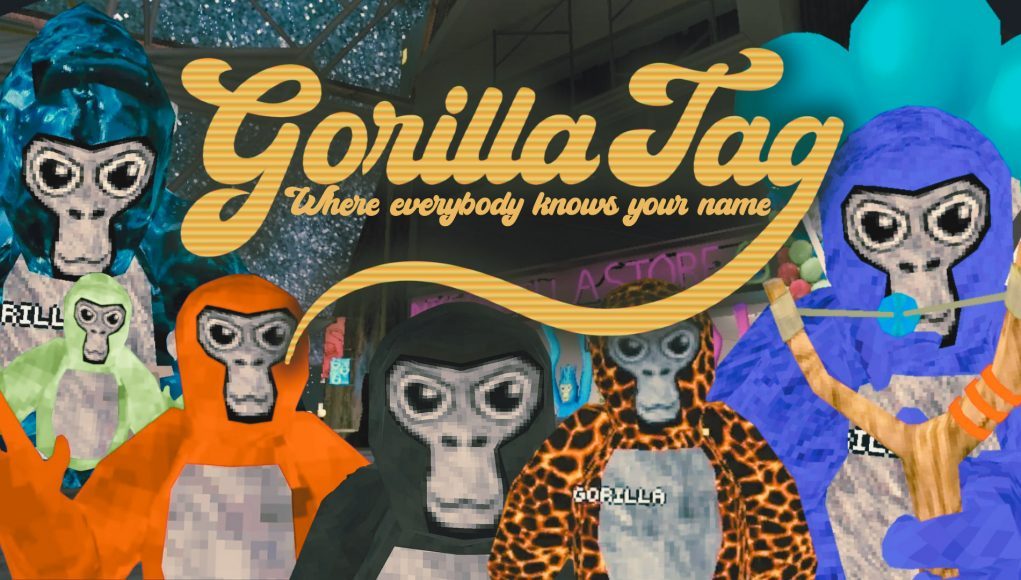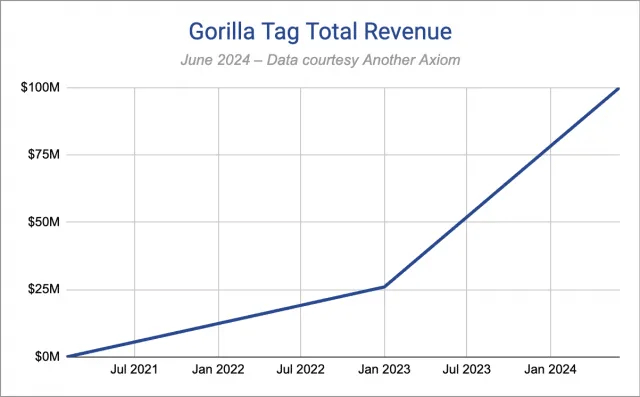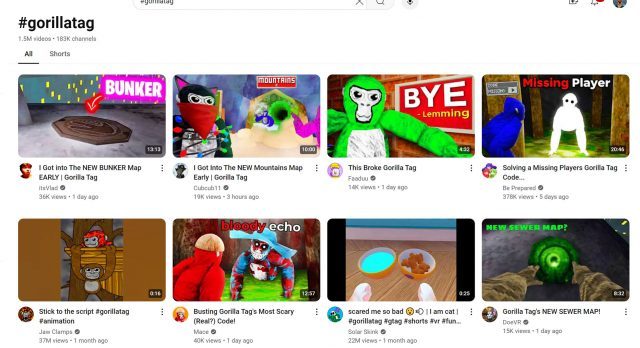1 in 3 Quest owners have downloaded Gorilla Tag, making it the most successful game ever on standalone VR. Gorilla Tag, created by studio Another Axiom, has emerged as a standout success in the virtual reality gaming space, not just as a game but as a cultural phenomenon. Launched in 2021, it has quickly amassed over 12 million users and generated more than $100 million in revenue.
Guest Article by JP Minetos
JP Minetos works on the Investment Team at Hartmann Capital, a frontier venture fund investing in Games, VR/XR, Generative AI, and immersive technology, with companies including Flat2VR, Sinn Studio, Tripp, and ShapesXR. JP focuses on VR and Social Gaming, and has worked closely with many top developers on the Quest store. His X account is @jpminetos where he shares data and perspectives on XR & the games market. Investment inquiry can be made via DM on X or LinkedIn.
While other games have seen success in VR, Gorilla Tag is unique in that it combines social interaction with a movement system that only works in VR. Much like other revolutionary free-to-play games, such as Fortnite and League of Legends, Gorilla Tag has carved out its own space by fostering a community-driven ecosystem that keeps over a million players coming back daily.
Its rise also signals the emergence of a new sector of games—those built exclusively for VR—driven by the immersive experience only this platform can offer. At the heart of this success is the game’s social nature, compelling gameplay loop, and creative use of free-to-play monetization. However, being primarily played by young teenagers, it sits outside the cultural zeitgeist as a popular game and isn’t covered to nearly the same scope as other successful titles. So why is Gorilla Tag so popular?

Why Gorilla Tag is Successful
Whilst VR falls short against other gaming platforms in compute power, the medium has an over powered feature for engagement: Player embodiment. Unlike flatscreen games where users control a character with a keyboard or controller while looking at a screen, VR players embody characters, making them feel as if they truly are the main character.
This means that spatially native social interactions are more akin to hanging out in real life, rather than zoom. The technical-social disconnect is heavily diminished. Gorilla Tag is at its core a social space with a game of ‘tag’ as the engagement loop. Similar to a poker night with friends or a pickup basketball game, the reason people play is partly for the game itself and partly social.
Gorilla Tag is designed with this in mind and is built to reflect the social nature of the game. Players spawn in a small hub inside of a tree. As soon as they step outside, they’re placed in a random social lobby and thrusted into the playground with a dozen others already there; no searching for servers or waiting for matchmaking.
Voice chat is turned on by default and doesn’t require a press-to-talk action. Players speak into the world, and everyone in the server can hear them. The audio uses spatial proximity chat, where voices vary in position and volume based on players’ physical locations relative to one another.
These circumstances foster natural camaraderie, as players form friendships with those they spend time with. They often ‘friend’ one another on the Horizon platform (Meta Quest’s Operating System) and create private lobbies to continue playing together at different times.
One of the most intriguing observations in user interactions is the natural adherence to in real-life (IRL) social norms. While kids may spam words, groups often physically gather, form social circles, make eye contact, and focus on the speaker. However, if a conversation becomes dull, it’s not seen as rude to leave and start climbing branches. There’s little dead social time or awkwardness. With enough people in a server, multiple subgroups often form, allowing players to hop between them or join a different server, given the ~50,000 concurrent users online.
A common critique among older Gen Z is the “death of the third place”—a space to gather outside of school/work and home. Social media has poorly filled this void, as authentic interaction feels fragmented and lacks the depth of real-life connections.
It’s clear that Gorilla Tag, predominantly played by boys aged 10-18, has become their third place. One-third of the game’s monthly players are logging in daily, with server activity peaking after school hours. Kids are drawn not just by the game itself, but by the chance to meet friends and play on a virtual playground.
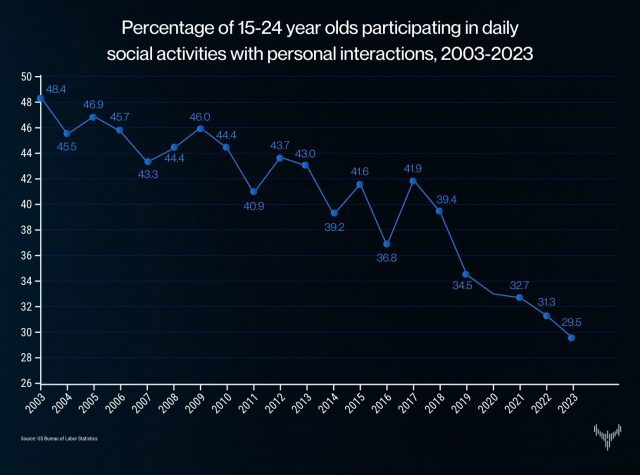 To foster a social environment, users need to spend time in a dedicated space for interaction. While Gorilla Tag’s average session time isn’t publicly available, the average for Quest content overall is around 30 minutes—significantly higher than traditional social media. I estimate Gorilla Tag’s average session time to be even longer, similar to other successful VR multiplayer titles, around 60 minutes.
To foster a social environment, users need to spend time in a dedicated space for interaction. While Gorilla Tag’s average session time isn’t publicly available, the average for Quest content overall is around 30 minutes—significantly higher than traditional social media. I estimate Gorilla Tag’s average session time to be even longer, similar to other successful VR multiplayer titles, around 60 minutes.
This would align with the average PC gaming session length of approximately 58 minutes (with the top 12% of players reaching 5 hours, making this a conservative estimate).
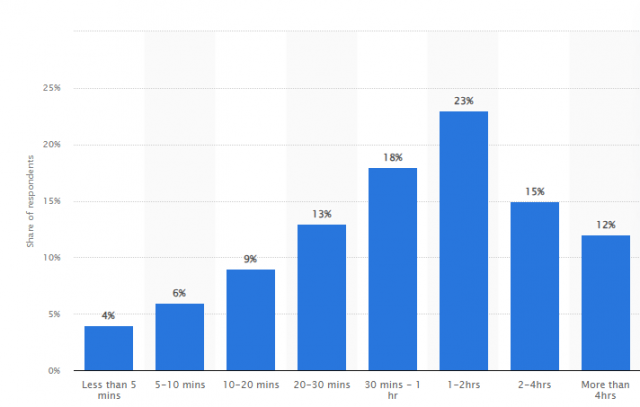 It’s important to note that these statistics reflect single sessions, and users often have multiple sessions in a day. However, Gorilla Tag excels in retaining users within a single social space, unlike social media, where users frequently jump between different threads or interactions.
It’s important to note that these statistics reflect single sessions, and users often have multiple sessions in a day. However, Gorilla Tag excels in retaining users within a single social space, unlike social media, where users frequently jump between different threads or interactions.
Status and In-Game Purchases
The key question remains: how has a free-to-play game like Gorilla Tag managed to generate $100 million in revenue?
While the game is free on the Meta’s Horizon Store, it is priced at $20 on Steam, though the vast majority of installs—over 90%—are on the Horizon platform.
Prior to the mobile gaming revolution, most games monetized through traditional models such as paid titles, downloadable content (DLC), or subscription services like World of Warcraft. However, mobile gaming was a pivotal moment for the free-to-play model, which has since evolved to encompass more complex monetization strategies, including microtransactions in AA and AAA titles.
With 12 million unique users and $100 million in revenue, Gorilla Tag boasts an impressive figures for a free-to-play game. But how exactly does the game generate this revenue? The answer lies in in-game cosmetics.
Given Gorilla Tag’s emphasis on social interaction, players naturally seek ways to express their individuality and status within the game. Cosmetics offer a powerful tool for this, allowing players to personalize their characters in ways that reflect their personalities and achievements. This creates a sense of identity and social prestige within the community, especially when certain items become status symbols.
Within the game, there is a dedicated store area that players physically travel to. Hot and seasonal items are available on a rotating basis, often for a limited time, adding a sense of urgency to purchases. This setup mimics real-world shopping experiences and taps into scarcity-based consumer psychology, where players want to show off their unique or rare cosmetics to others in the game.
The in-game purchasing process is frictionless. Players can quickly browse and select items inside of Gorilla Tag with only one additional Horizon OS confirmation pop-up to finalize transactions. By minimizing the steps needed to make a purchase—and a browsing and try-on process that mimics real-life shopping—Gorilla Tag ensures that players can seamlessly acquire new items, making the buying experience smooth and unobtrusive.
As a result, players regularly purchase new items to keep their avatars fresh and distinctive. This constant cycle of cosmetic updates, combined with a user-friendly transaction flow, has proven to be a highly effective monetization strategy, leading to the game’s significant financial success, unseen before for free-to-play VR titles. Another VR title to surpass $100 million in revenue, Beat Saber, charges for the base-game, with additional revenue thanks to DLC offerings which add more songs and levels to the game.
Continue on Page 2: Less friction → More play time »
Less friction → More play time
One of the biggest hurdles for widespread VR adoption is the inherent hardware and user experience (UX) friction associated with accessing VR content. On the hardware side, users need a charged headset, a suitable play area, and the motivation to physically put on the headset. These challenges are universal across all VR applications, including Gorilla Tag.
To alleviate the impact of that friction, Gorilla Tag addresses a different type of friction, specifically tied to UX design. A common complaint in VR gaming is the tedious process players go through just to start an experience, often involving 2D menus, loading screens, and multiple steps before entering the game world. This can feel clunky and counterintuitive for a 3D environment, and if players encounter too many barriers, they may lose interest or abandon the session altogether.
Gorilla Tag mitigates this friction by streamlining the player’s journey from game launch to social engagement. When players start the game, they bypass traditional main menus and complex interfaces. Instead, they are immediately placed into a hub from which they can ‘physically’ navigate into a social lobby with no extra steps. This simple design significantly reduces the time between launching the game and participating in its core experience.
The entire process—from pressing start on the Quest home screen to being inside a social lobby—takes about 10 seconds. This near-instant transition eliminates much of the friction typically associated with VR gaming, allowing players to jump right into the action. By making the game loop accessible in seconds, Gorilla Tag removes one of the key frustrations of VR, contributing to its high retention and daily active user base.
Demonstration of going from putting on my Quest to being in a Gorilla Tag social lobby: ~12 seconds.
Unique to VR: Gorilla Tag’s Groundbreaking Locomotion
When we think of the most talked-about and successful VR games, what do they all have in common? They share a design philosophy that leverages the core strengths of VR—specifically, the immersive tech stack that includes motion controls, six degrees of freedom (6DoF), and spatial awareness. These elements create experiences that are uniquely tailored to VR, making them impossible to replicate on traditional gaming platforms.
Gorilla Tag exemplifies this approach, offering an experience that is not only compelling but also fundamentally tied to the VR medium. At the heart of this is its innovative locomotion system, colloquially known as ‘Gorilla Locomotion.’ Traditionally, player movement in games has been controlled by joysticks or other digital inputs, where characters move in the direction indicated by the controller. Gorilla Tag, however, breaks this mold by requiring players to physically swing their arms to propel themselves through the game world.
Instead of relying on button presses, players use their real, physical arms (which are mirrored by their virtual arms) to push themselves in the desired direction. The only other control input is a grab function that allows players to cling to surfaces. This system is intuitive yet challenging, like learning to ride a bike. It feels awkward at first, but over time, players become more skilled and fluid in their movements. This design invites a more immersive form of play that’s impossible to replicate with traditional game controllers.
There is only a basic, self-serve tutorial to teach the fundamentals of movement. However, new players are often encouraged to ask for tips from more experienced players, fostering a sense of community and shared learning. Veteran players frequently assist newcomers, showing them how to master the game’s core mechanics, such as swinging from branches or scaling trees.
This dynamic movement system sits in the ‘easy to learn, difficult to master’ range, making it highly rewarding for players as they improve. It’s similar to genre-defining games like Counter-Strike or Rocket League, where mastery comes with practice and dedication. This rewarding feedback loop is a major reason why players keep coming back. Gorilla Locomotion has been so successful that it has spawned its own category of VR locomotion, incentivizing other developers to create movement systems that can only exist in virtual reality.
Gorilla Tag has designed a system that feels natural yet challenging and ensures that its gameplay remains deeply tied to the physicality and immersion of VR. This is not a game that could be ported to a traditional screen with a joystick—it’s fundamentally a VR experience, and it helps to keep player retention inside the game.
The Memeability and Social Media Presence of Gorilla Tag
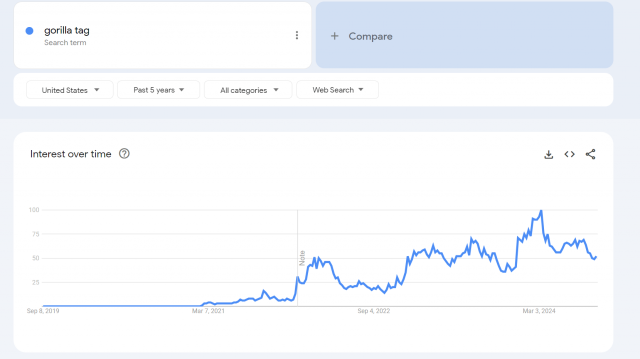 One of the key drivers of Gorilla Tag’s virality is its popularity across social media platforms. Its memeable nature and easy-to-share gameplay have made it a hit among content creators, particularly on platforms like TikTok, YouTube, and Twitch. The game’s distinctive art style and chaotic, physical movement make for highly entertaining clips, leading to millions of views and shares. The rise of user-generated content, from memes to full-length gameplay videos, has contributed to the game’s growing community, with players often showcasing their skills, humorous interactions, or unexpected moments in lobbies. The game’s open-ended nature and social core make fertile ground for this kind of user-generated content.
One of the key drivers of Gorilla Tag’s virality is its popularity across social media platforms. Its memeable nature and easy-to-share gameplay have made it a hit among content creators, particularly on platforms like TikTok, YouTube, and Twitch. The game’s distinctive art style and chaotic, physical movement make for highly entertaining clips, leading to millions of views and shares. The rise of user-generated content, from memes to full-length gameplay videos, has contributed to the game’s growing community, with players often showcasing their skills, humorous interactions, or unexpected moments in lobbies. The game’s open-ended nature and social core make fertile ground for this kind of user-generated content.
In particular, Gorilla Tag lends itself to the type of organic, spontaneous content that social media algorithms favor. Videos of players flailing their arms to move, dramatic chase sequences, or hilarious voice chat moments quickly go viral, enticing new players to join in on the fun. Creators across different platforms have built entire followings based on Gorilla Tag content, further embedding the game into the social media fabric. As a result, the game benefits from constant word-of-mouth marketing, with each viral clip acting as free advertising. In an era where games often live or die by their presence on platforms like TikTok, Gorilla Tag has mastered the art of staying relevant by being inherently shareable.
Gorilla Tag’s Impact on the Future of VR Gaming
Gorilla Tag has not only proven to be a financial success but has also set a new standard for what VR games can achieve. Its innovative approach to player movement, its seamless integration of social interaction, and its free-to-play model are shaping the future of VR gaming.
In an industry where hardware limitations and user friction are common barriers, Gorilla Tag has shown that a well-designed game can break through those challenges and create a lasting impact—divorcing the idea that VR games are not commercially scalable.
As VR technology continues to evolve, the lessons from the game’s success influences the next generation of VR titles. From its unique locomotion system to its organic social spaces, Gorilla Tag has set the precedent on how VR can offer experiences that are impossible on other platforms. In doing so, it has helped usher in a new era of social VR gaming, recentering the definition of social.
With its ongoing updates, expanding player base, and cultural resonance, Gorilla Tag is more than just a game—it’s a movement. Its success shows that virtual reality has the potential to transform gaming by offering players a truly immersive, social, and unforgettable experience.
The VR social renaissance is soon in full swing—and Gorilla Tag is only the first of many more success stories to come. We are here to find the next.

